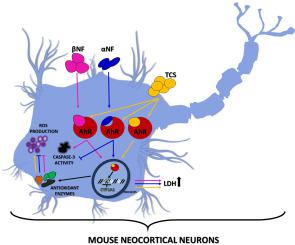当前位置:
X-MOL 学术
›
Pestic. Biochem. Phys.
›
论文详情
Our official English website, www.x-mol.net, welcomes your
feedback! (Note: you will need to create a separate account there.)
The interference of alfa- and beta-naphthoflavone with triclosan effects on viability, apoptosis and reactive oxygen species production in mouse neocortical neurons
Pesticide Biochemistry and Physiology ( IF 4.2 ) Pub Date : 2020-09-01 , DOI: 10.1016/j.pestbp.2020.104638 Konrad A Szychowski 1 , Kamila Rybczyńska-Tkaczyk 2 , Jan Gmiński 1 , Anna K Wójtowicz 3
Pesticide Biochemistry and Physiology ( IF 4.2 ) Pub Date : 2020-09-01 , DOI: 10.1016/j.pestbp.2020.104638 Konrad A Szychowski 1 , Kamila Rybczyńska-Tkaczyk 2 , Jan Gmiński 1 , Anna K Wójtowicz 3
Affiliation

|
Triclosan (TCS) is commonly used worldwide in a range of personal care and sanitizing products. A number of studies have revealed the presence of TCS in human tissues. It has recently been shown that TCS can interact with AhR in mouse neurons and the one of its effects is the stimulation of reactive oxygen species (ROS) production. Reactive oxygen species perform a wide spectrum of functions in neuronal cells, where they are generated as by-products of cellular metabolism. Therefore the aim of the study was to investigate effects of two synthetic naphthoflavones, the beta-naphthoflavone (βNF) and alpha-naphthoflavone (αNF), well known agonist and antagonist of AhR on TCS-stimulated cytotoxicity, apoptosis and ROS production in mouse primary cortical neurons in vitro cultures. The results showed that both agonist (βNF) and antagonist (αNF) of AhR enhanced the LDH release and caspase-3 activity stimulated by TCS. Interestingly, both naphthoflavones decreased the TCS-stimulated ROS production, however, they showed no scavenging properties as revealed by ABTS•+ and DPPH• methods. What's more, both βNF as well as αNF inhibited the activity of xanthine oxidase (XO) stimulated by TCS. Thus, we can assume that αNF or βNF act in a competitive way over TCS and inhibit its effect on antioxidant enzyme activity.
中文翻译:

α-和β-萘黄酮干扰三氯生对小鼠新皮质神经元活力、细胞凋亡和活性氧产生的影响
三氯生 (TCS) 在全球范围内广泛用于一系列个人护理和消毒产品。多项研究表明,人体组织中存在 TCS。最近表明,TCS 可以与小鼠神经元中的 AhR 相互作用,其作用之一是刺激活性氧 (ROS) 的产生。活性氧在神经元细胞中发挥着广泛的功能,它们是细胞代谢的副产品。因此,本研究的目的是研究两种合成萘黄酮,β-萘黄酮 (βNF) 和α-萘黄酮 (αNF),众所周知的 AhR 激动剂和拮抗剂对 TCS 刺激的小鼠原代细胞毒性、细胞凋亡和 ROS 产生的影响。皮层神经元体外培养。结果表明,AhR 的激动剂 (βNF) 和拮抗剂 (αNF) 均增强了 TCS 刺激的 LDH 释放和 caspase-3 活性。有趣的是,这两种萘黄酮都降低了 TCS 刺激的 ROS 产生,然而,它们没有显示出 ABTS•+ 和 DPPH• 方法所显示的清除特性。此外,βNF 和 αNF 均抑制 TCS 刺激的黄嘌呤氧化酶 (XO) 的活性。因此,我们可以假设 αNF 或 βNF 以竞争方式作用于 TCS 并抑制其对抗氧化酶活性的影响。βNF 和 αNF 均抑制 TCS 刺激的黄嘌呤氧化酶 (XO) 的活性。因此,我们可以假设 αNF 或 βNF 以竞争方式作用于 TCS 并抑制其对抗氧化酶活性的影响。βNF 和 αNF 均抑制 TCS 刺激的黄嘌呤氧化酶 (XO) 的活性。因此,我们可以假设 αNF 或 βNF 以竞争方式作用于 TCS 并抑制其对抗氧化酶活性的影响。
更新日期:2020-09-01
中文翻译:

α-和β-萘黄酮干扰三氯生对小鼠新皮质神经元活力、细胞凋亡和活性氧产生的影响
三氯生 (TCS) 在全球范围内广泛用于一系列个人护理和消毒产品。多项研究表明,人体组织中存在 TCS。最近表明,TCS 可以与小鼠神经元中的 AhR 相互作用,其作用之一是刺激活性氧 (ROS) 的产生。活性氧在神经元细胞中发挥着广泛的功能,它们是细胞代谢的副产品。因此,本研究的目的是研究两种合成萘黄酮,β-萘黄酮 (βNF) 和α-萘黄酮 (αNF),众所周知的 AhR 激动剂和拮抗剂对 TCS 刺激的小鼠原代细胞毒性、细胞凋亡和 ROS 产生的影响。皮层神经元体外培养。结果表明,AhR 的激动剂 (βNF) 和拮抗剂 (αNF) 均增强了 TCS 刺激的 LDH 释放和 caspase-3 活性。有趣的是,这两种萘黄酮都降低了 TCS 刺激的 ROS 产生,然而,它们没有显示出 ABTS•+ 和 DPPH• 方法所显示的清除特性。此外,βNF 和 αNF 均抑制 TCS 刺激的黄嘌呤氧化酶 (XO) 的活性。因此,我们可以假设 αNF 或 βNF 以竞争方式作用于 TCS 并抑制其对抗氧化酶活性的影响。βNF 和 αNF 均抑制 TCS 刺激的黄嘌呤氧化酶 (XO) 的活性。因此,我们可以假设 αNF 或 βNF 以竞争方式作用于 TCS 并抑制其对抗氧化酶活性的影响。βNF 和 αNF 均抑制 TCS 刺激的黄嘌呤氧化酶 (XO) 的活性。因此,我们可以假设 αNF 或 βNF 以竞争方式作用于 TCS 并抑制其对抗氧化酶活性的影响。











































 京公网安备 11010802027423号
京公网安备 11010802027423号